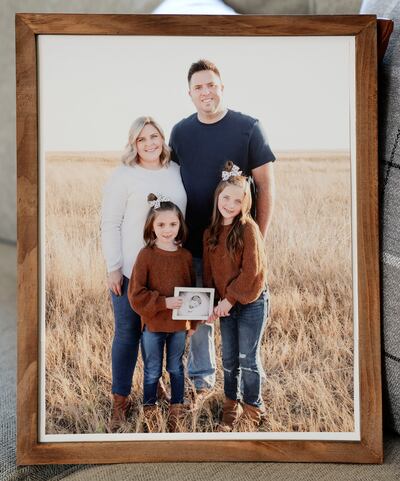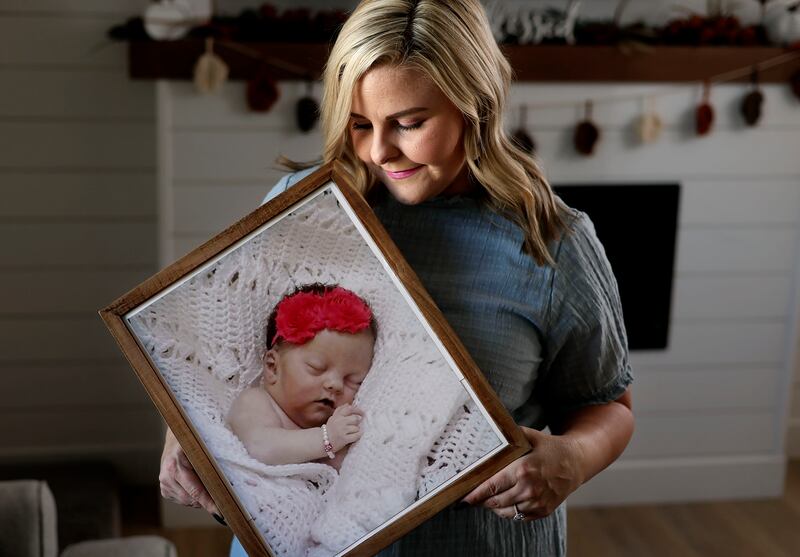Editor’s note: This article mentions miscarriage and infant mortality.
I thought I was safe. Or more precisely, I thought our unborn baby was safe. After a dozen early miscarriages in a row, I had made it into the second trimester, we had seen and heard the baby’s heartbeat, and I had even begun to feel her tiny movements. I let myself believe that I would hold this baby in my arms.
And then I started to bleed.
At the hospital, in labor at 17 weeks (40 weeks is full-term), I learned that the baby had died. I was shattered. Shattered. I delivered her tiny body in the emergency room. She had fingers and toes, tiny eyelids and tiny ears. She was perfect in every way — except for a heart that no longer beat.
We named her Aimée, French for “loved” and she was. She was born 30 years ago this December, five days before my 28th birthday, and I was plunged into the depths of grief. I heard phantom baby cries. My arms literally ached. My chest felt like an elephant was sitting on it — I could barely breathe. I couldn’t sleep and spent many nights rocking myself in a rocking chair. I wanted to crawl out of my own skin or get an epidural for my heart so I couldn’t feel anymore. I thought I might be losing my grip on my sanity.
And all the while, a drumbeat played in my head: My baby is dead. My baby is dead. My baby is dead.
It’s the “club” no parents want to belong to — the club for parents who’ve lost a baby. But that club is a big one. Approximately 1 in 4 pregnancies in the United States end in miscarriage — around a million a year — and almost 50,000 more are stillborn or die in infancy every year. That’s a lot of grieving parents.
In the days, weeks and months that followed Aimée’s death, I felt really alone. It seemed like no one knew how to help me — not my husband, my neighbors or friends. I didn’t know how to help myself. In 1992, when Aimée died, I didn’t know that four years earlier, President Ronald Reagan had declared October to be Pregnancy and Infant Loss Awareness Month. On that day, he said “When a child loses his parent, they are called an orphan. When a spouse loses her or his partner, they are called a widow or widower. When parents lose their child, there isn’t a word to describe them.”
Today, there are more resources and it’s easier to find information about grief and loss than 30 years ago. For example, those strange symptoms I had after Aimée died? Turns out they’re normal. I did not realize the day Aimée was born how much I would want photographs to remember her 30 years later. I don’t have any, and it makes me sad.

Amber Heaps lost her daughter Oakley almost 10 years ago when Oakley was just 4 days old. The photos they have of Oakley are not only treasured memories, but a way for their younger children who never met their older sister to feel connected to her. Oakley’s photo is still included in all family photos. Amber said, “I am so grateful to have the pictures we do of Oakley because, with her being our first baby, her sisters wouldn’t be able to have the connection with her that they do. We lived away from family when she was born so our siblings never got to meet her. Having her picture helps us keep her memory alive and reminds us to live as we know we should, so we can return and be with Oakley again.”
Amber’s friend Mattie June Hearst started supporting families in loss when Amber lost Oakley. After learning about Now I Lay Me Down to Sleep, which links professional photographers with families who have just lost their baby at 26 weeks or later, she began volunteering as a photographer. Then, Mattie lost her own baby at 14 weeks and realized how important photos can be at any stage.
Mattie was particularly well-informed about her options, and about the types of things that would be meaningful not only then, but down the road. She took pictures of her baby. She found something that could be a tangible reminder of her baby — in her case, a necklace. She held a memorial service. She named her baby, she talked about her baby and she was open about what was helpful and what was less helpful.
“People just want to talk about their lost child,” she told me. Let them lead the conversation, but it’s OK to ask about their baby just as you would about a living baby. “What’s her name?” “What color hair does he have?” And, she noted, it’s OK if you don’t know what to say — the bereaved parents have plenty to say when they have supportive listeners.
On the other hand, “If what you are going to say starts with ‘at least,’ just don’t,” she said.
To parents who are still in the early days of loss, I want you to know that it does get better. You will adapt to a new normal and the grief, while never gone, will lose some of its sharpest edges. You will smile again. You will feel joy again. In the meantime, lean on others for support as you navigate this path. You are not alone.
Tonight, Oct. 15, at 7 p.m., there will be a “wave” of candles lit at 7 p.m. in remembrance of our lost babies. I will light mine in honor of Aimée, Oakley and all the other babies who left us far too soon.
Holly Richardson is the editor of Utah Policy and a joyful, busy and bereaved mother.


